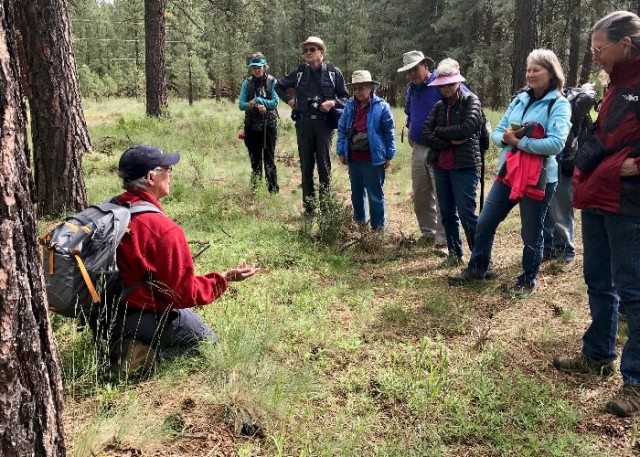Central Oregon Range Wars
Published 12:00 am Saturday, July 7, 2018

- Above left, Mountain climbing was a major summer event for the Skyliners throughout the early 1930s. Emil Nordeen is seated at the right. (Emil Nordeen Collection) Above right, The sled hill at McKenzie Pass, from Pine Echoes, the Brooks-Scanlon newsletter.
More than 120 years ago, cattle-men and sheepherders of Central Oregon were locked in a deadly range war. At issue, who had the right to graze their animals on federal lands. Many generations later, the range war is still a touchy topic in towns all over the area, with some families doing their best to forget about what happened.
The Wild West was not always settled in the most equitable of ways. The law of the land was mostly on the side of the people with the guns. It may sound far-fetched to many, but Central Oregon was the site of a conflict that pitted gun-toting cattle ranchers against nomadic sheepherders.
Trending
“It’s called the Sheep Range Wars, but it was actually a part of the Sheep Slaughter Wars, because the sheepmen didn’t go out and kill cattle,” said Bowman Museum historian Steve Lent. “They tried to solve things through the legal channels, whereas the cattlemen took direct action to eliminate sheep.”
During the 1800s, the U.S. government encouraged western migration to settle what would become the Oregon Territory in 1848. The Homestead Act of 1862 enabled settlers to claim 160 acres to establish farms and ranches. Early Central Oregon pioneers took advantage of the abundant land to graze cattle and sheep, and suitable Upper Deschutes River lands were settled during the late 19th and early 20th centuries.
Afraid the various generous homestead acts would place too much valuable timberland in private hands, in 1891 Congress passed the Forest Reserve Act. The hope was to stymie efforts by timber companies to get access to timber-rich lands illegally. Congress had no intention of creating conflict between cattle and sheep ranchers, but that’s exactly what happened.
“The range wars started here around 1894,” Lent continued. “Up until that time, sheep were grazed farther up in the Cascade Mountains and cattle on many other various spots.”
Cows and sheep graze differently. Cows are picky eaters. They steer away from anything unpleasant like weeds. When a large herd of sheep go through an area, on the other hand, there is nothing left but dirt. And there were a lot more sheep than cattle.
“Haycreek Ranch was operating with 100,000 sheep by themselves,” said Lent.
Trending
The situation was exacerbated by the influx of out-of-area sheepherders into the Blue Mountains to graze their animals.
“Sheepmen from Ashwood, Richmond, and Mitchell would summer graze their sheep in the Ochocos,” said Lent. “Eventually, hundreds and thousands of sheep grazed the area.”
As the range got more crowded, the cattle ranchers decided enough was enough. By 1894, tensions had reached a boiling point.
“The brewing conflict led to groups being formed called the Sheep Shooters organizations,” said Lent. “The cattlemen would meet to plot strategies to keep sheep off what they thought were their traditional rangelands.”
Few written accounts are available, in part due to the highly illegal activities. One of the main sources of information about the range wars in Central Oregon were the journals of Charles Congleton, who was the first forest ranger in the Blue Mountain Forest Reserve, later named the Ochoco National Forest.
In early 1927, Congleton started collecting stories from old-timers in the area. He was particularly interested in gathering information about the range wars, which he chronicled in a report to his supervisor.
The Izee Sheep Shooters were established in 1896 in the small town of Izee in Grant County. According to Congleton’s report, “When the sheep came too near their ranches a bunch of sheep-shooters would get together and go out and hold up the herder and camp tender and then would kill a good portion of the band of sheep.”
Rumors of the Izee Sheep Shooters quickly spread and in July 1898, a representative from the organization was invited to attend a meeting with Paulina cattlemen. According to Congleton’s journal, the meeting got underway just before midnight under a “lone yellow pine tree about 24 inches in diameter and quite short and stubby, standing in the narrow creek bottom of Wolf Creek.”
Twenty-five to 40 men had gathered around a large bonfire to hear Izee cattleman Henry Snodgrass speak. The late night meeting led to the establishment of the Paulina Sheep Shooters. Other local sheep shooter associations quickly popped up all around the area, among them the Silver Lake Sheep Shooters.
Initially, the sheep shooters resorted to scaring local sheepherders. The cattlemen also marked up their territory with cloth posters saying “Keep Sheep Out,” and by blazing trees, stripping the bark off one side as a signal.
“They were called ‘deadlines,’” said Lent. “If any sheep were found beyond that, they were set to be killed.”
At first, the sheepmen didn’t take the warning signs seriously. According to Congleton, they continued grazing their animals “right down to the cattlemen’s pasture fences.”
As the number of sheep increased, the range wars escalated beyond random attacks on the sheepherders. The sheep shooters began to resort to large-scale slaughter of thousands of sheep, or “meadow maggots,” as the cattle ranchers called them.
“The largest known killing of sheep was by Benjamin Lake, south of Hampton, where they ran a whole bunch of sheep off a cliff,” said Lent.
According to Congleton’s journal, the April 28, 1903, raid at Benjamin Lake ended with the loss of 2,400 sheep. The number may have been an overstatement by Congleton’s source. Lent estimated the number of dead sheep at 1,500.
The Benjamin Lake incident was an anomaly, according to Lent.
“More frequently, it was in smaller bands, anywhere from 150 to 500. In some cases, they killed sheep that were on the sheep owner’s own land.”
The sheepherders tried to deal with the situation in a peaceful manner. In May 1904, a delegation of sheepmen from Antelope met with cattle ranchers from Crook County to negotiate an end to the range wars. Sensing they had the upper hand in the conflict, the cattlemen were not interested.
The sheepmen also took to the pages of local newspapers to state their case. Locally, the Crook County Journal published an editorial in May 1904, saying the Wool Growers’ Association had offered a $1,500 award for “information leading to arrest and conviction of any persons guilty of . . . killing, maiming or otherwise unlawfully and with malicious intent destroying the sheep of a member.”
The editorial writer said he understood the plight of the members of the association, but put the blame for the range wars on the sheepmen.
“Wouldn’t existing conditions have remained a trifle less strained if this association, instead of offering a reward for information leading to the arrest of anyone found guilty of the injuring the property of its members, had offered that amount of money for information leading to the arrest and conviction of any of its own members found grazing his herds outside the territory which the Crook County stockman in his gener-osity has granted him?”
The Portland Morning Oregonian also published several articles about the sheep shooter’s forays into sheep country. But the cattle ranchers pushed back. In a letter to the editor in December 1904, the sheep shooters wrote:
“I am authorized by [the Inland Sheep Shooters] to notify the Oregonian to desist from publishing matter derogatory to the reputation of sheep-shooters in Eastern Oregon. . . . We would thank the Oregonian and the Governor to attend strictly to their business and not meddle with the settlement of the range question in our province.”
Further on in the letter, they told the editor that if the cattlemen wanted to shoot sheep to protect their grazing lands, it was their right to do so.
“If we want more range we simply fence it in and live up to the maxim of the golden rule that possession represents nine points of the law.”
The range wars climaxed between 1904 and 1906, eventually ebbing with the establishment of the U.S. Forest Service in 1905. On April 11, 1906, the Western Division of the Blue Mountain Forest Reserve and Maury Mountain Forest Reserve came under the administrative rule of the fledgling government agency, with A. S. Ireland installed as the forest supervisor with headquarters in Prineville.
In a last-ditch effort to carve out grazing grounds and block sheepmen from accessing rangelands, the Crook County Cattlemen’s Association proposed a six-mile-wide strip of land along the south and west boundaries of the Blue Mountains and all of the Maury Mountain Forest Reserve for their exclusive use. The only animals to be grazed in the area would be cattle and horses. Forest Inspector H. D. Langille denied the request.
Although the sheep shooter’s associations gave their members the right to kill troublesome sheepherders in principle, there is no definite proof anyone actually perished due to the range wars. How-ever, there is still much controversy surrounding the murder of Conn Brier.
“There is suspicion it was brought on by the range wars,” said Lent. “But the [murder] is under questionable circumstances.”
The disappearance of Shorty Davis, a wealthy sheep owner who ran sheep in the Crooked River Valley in the early 1900s, may also have been connected to tensions over the range wars.
Generations later, the range wars are still a hot-button issue in many towns in and around the Ochoco National Forest. According to Lent, there are still lingering undertones in the Prineville area.
“Just because it happened at the turn of the 20th century, it still is a hot topic. Even though things happened during that family’s past, it’s nothing they like to discuss.”
There are still visible marks of the range wars more than a century later. Blazes or “deadlines” can still be seen on trees in the area. The old pine tree where the sheep shooters planned their raids was still around when Congleton wrote his 1927 report to his supervisor. But according to Lent, “the Sheep Shooter’s Tree” was hit by lightning and burned down. Maybe an appropriate ending to the Central Oregon Range Wars.








